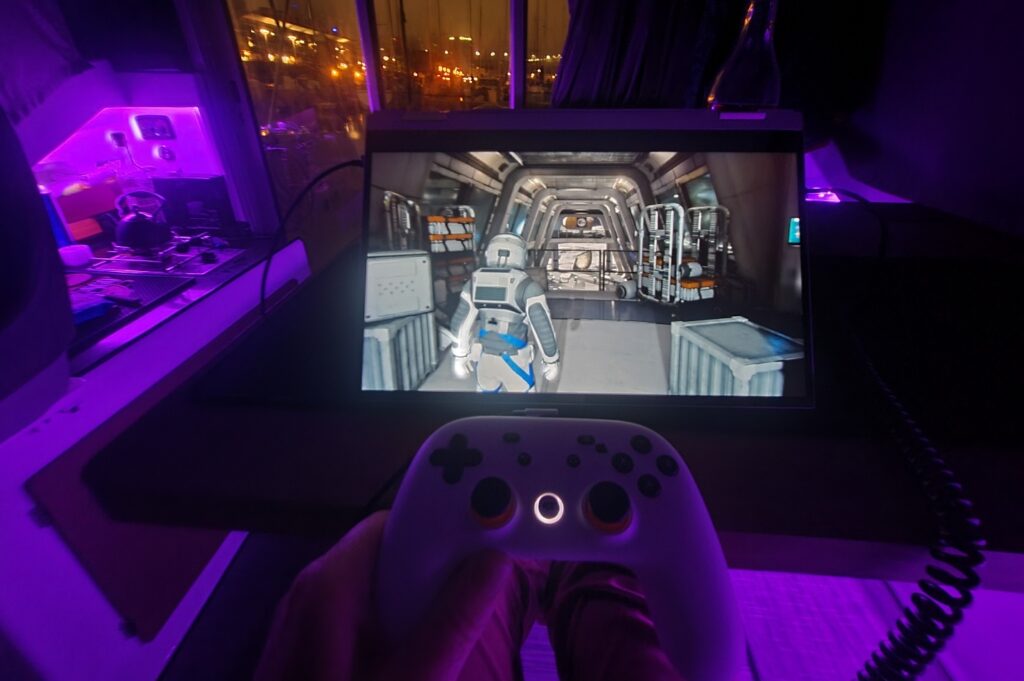In a non-scientific test of the current test bed for cloud gaming using a spotty 5G mobile connection, the gameplay gets a passing mark. However, watch out for those hotspot data costs.
By Ted Pollak

As part of my research duties, I try to keep at least one iteration of each video game platform category active in my office environment. Google Stadia is the current test bed for the cloud gaming category. Until now, I had been evaluating it solely on a high-speed cable Internet connection using a 5G wireless modem to connect to a TV via Chromecast Ultra. Overall, the performance has been excellent considering the value and flexibility, providing a perceived 90% visual and play quality, compared to local processing platforms (PC, console, handheld). If I plugged the modem’s Ethernet cable directly into the Chromecast, I’d wager this would bump the experience to 95% for my connection and location relative to the game server.
Nevertheless, I have been selective in the types of games I play via cloud. Every game has a specific sensitivity to latency (control input to display render). The ultimate stress test for cloud gaming is, of course, a multiplayer twitch shooter with players widely distributed geographically. Because I use local processing platforms for the top titles with my limited gaming time, why tempt fate with performance on cloud? For cloud, I choose action games (like Tomb Raider), turn-based games (like XCOM), and select indie/casual games—all of which are more latency tolerant. For those confused by latency, anything over 50 ms (1/20th of a second) of action/reaction delay can penalize the experience in a multiplayer twitch shooter. But in a game of chess, 5,000 ms of latency (5 seconds) would not necessarily ruin the game.
Knowing that the more latency tolerant a game is, the better cloud performance it will have, I try to choose games that don’t stress the latency parameter. For this test, I selected Deliver Us the Moon, a third- and first-person “slow” action and puzzle game based on rockets, space stations, and the lunar surface.
I selected a boat docked in a harbor to test Deliver Us the Moon on a T-Mobile 5G connection. My Samsung Galaxy Note20 Ultra served as the hotspot and Samsung notebook served as the display. The first thing to note is that Chromecast is not necessary for this setup. The Stadia (or other brand) controller just needs to be connected to the notebook (or any PC or Mac) via USB cable. Some can do Bluetooth, but why add the latency? Each “hop” from control input to game server and back just adds more.
Also very important is the quality of the mobile 5G connection. In this case, T-Mobile was having issues with the tower in the harbor area and it was “under maintenance.” I was getting fast but inconsistent speeds. Adding to the challenging environment, radio waves do not like coastal areas very much because there are limited objects to bounce the radio waves around; also, water absorbs waves. So, this test was not “scientific” in that I conducted it during the conditions that I had at the time and did not commit to testing in multiple conditions, which, of course, skews the results.
The end result was a perceived experience quality rating of 80%, compared to local processing—with 70% the minimum quality rating to play on cloud at all, in my opinion. The graphics were crisp at 1080p most of the time. There were a few “stutter and pixilation events” during some cutscenes and gameplay. But I enjoyed the game, and that’s what matters. And the entire “platform” is a laptop, a connection, and a controller—easily packable to any location. The play session was timed to 2 hours, and my mobile data was measured at 4.24GB. With my plan, I get 60GB a month of hotspot data, beyond which I have to pay $10 a month more for an additional 40GB.
What do we think?
Cloud gaming is good technology. On a mobile 5G connection, it provides an excellent platform for random gaming sessions, but perhaps not as a primary platform due to the expense of mobile hotspot data from some carriers. Cloud gaming will get better as the “network edge” moves ever closer to the gamer.





